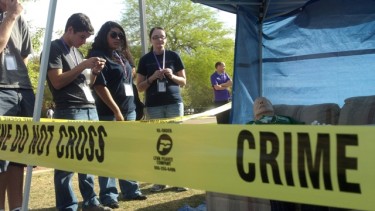By Michael Ferraresi
GCU News Bureau
Before he became a police officer, gang investigator and forensic expert, Cornel Stemley learned about criminal investigations — like many Americans — by watching TV.
He joked about the shows that inspired him as a teen, although his favorite sensational cop-dramas predated many of the nearly 1,000 students from Valley high schools and colleges who attended Thursday’s Forensic Science Day at GCU.
To many of those students, crime-scene processing happens in less than an hour, so that David Caruso and other actors can solve the crime in time for a commercial break.
In reality, Stemley and other experts who teach forensic science courses in GCU’s rapidly growing College of Arts and Sciences have examined murder scenes, collected evidence from unsolved fatal car accidents and documented blood-spatter patterns key to prosecutions for hours if not days.
“We didn’t have a CSI show on TV,” said Stemley, a former police officer who worked as a federal narcotics investigator in Nebraska before joining GCU as a forensic science instructor.
“We had ‘Quincy,’” he joked about the 1976 show about a coroner who primarily investigated murders. “What about ‘Colombo?’ What about ‘CHiPs?’”
Not many students showed recognition of those, although the crowd stayed focused through a morning of explanations mostly from professionals in the Phoenix Police Department Crime Lab.
The guest speakers told the student audience at GCU Arena about the reality: Their careers — while unglamorous — help solve crimes, put criminals in prison and bring closure to grieving families.
“It’s not sexy at all, trust me,” said Karla Raponi, a Phoenix police civilian crime scene specialist assigned to the department’s homicide unit.
“You’ve got your one chance. It’s not like you can go back next week and say, ‘Let’s test that again.’”
Crime scene specialist Shayleen Eastman, a nine-year veteran who spoke with Raponi, said she assisted in cataloging and documenting severed body parts in the 2009 murder of Terry Neely. The disabled Phoenix resident was tortured and dismembered. The murderer set his severed body parts on fire, drove a nail into his skull and stabbed him more than 50 times.
This spring, killer Angela Simpson was sentenced to life in prison plus an additional 14 years for the slaying. She confessed to the killing early in the investigation, although forensic evidence remained a critical element in the investigation.
Some Phoenix police described the Neely slaying as one of the most brutal they’d ever seen. For forensic experts and students, it’s an example of the dirty, smelly and disturbing nature of many crime scenes.
Forensic Science Day speakers showed photos of murder victims’ bodies, toilets filled with colorful unidentifiable substances and blood-spatter patterns illuminated by de-masking chemicals.
Experts in toxicology, firearms testing and DNA analysis from both Phoenix Police and the University’s forensic science program shared with students a glance at the range of career possibilities.
The forensic science program currently includes about 300 students, and the first graduate is expected this fall — the first of many expected to complete their degrees at GCU who share a curiosity about how evidence collection, DNA analysis and forensic biology help re-create crimes.
Dr. Mark Wooden, dean for GCU’s College of Arts and Sciences, said the forensic program is expected to continue to develop students to fill “high-need areas and also some of the highest-paying jobs” in areas of DNA analysis and other detail-oriented fields in laboratory science or criminal justice.
As part of its ground campus expansion, GCU’s new College of Arts and Sciences building will include state-of-the-art DNA analysis and forensic chemistry labs. The building is expected to be completed by this fall.
GCU’s forensic science program is regionally accredited by the Higher Learning Commission of the North Central Association of Colleges and Schools. Program director Melissa Beddow added that GCU is seeking accreditation by the American Academy of Forensic Science.
Some high school students who attended Forensic Science Day said they share the same curiosity about the dynamics of a crime scene. Others said they were interested in learning more about the GCU forensic science program and potential investigative careers.
Al Hurtado, 17, a junior at Avondale’s La Jolla High School, visited GCU with other students in his advanced anatomy class. He was intrigued by law enforcement careers, after learning about Stemley’s ascent from a patrol officer to investigator and forensic expert.
“When I see accidents, I wonder who hit who, I think about the angle of the impact of the cars,” Hurtado said. “After I heard what they do, it made me realize there’s more to a crime scene than you think.”
Contact Michael Ferraresi at 639.7030 or [email protected].
















